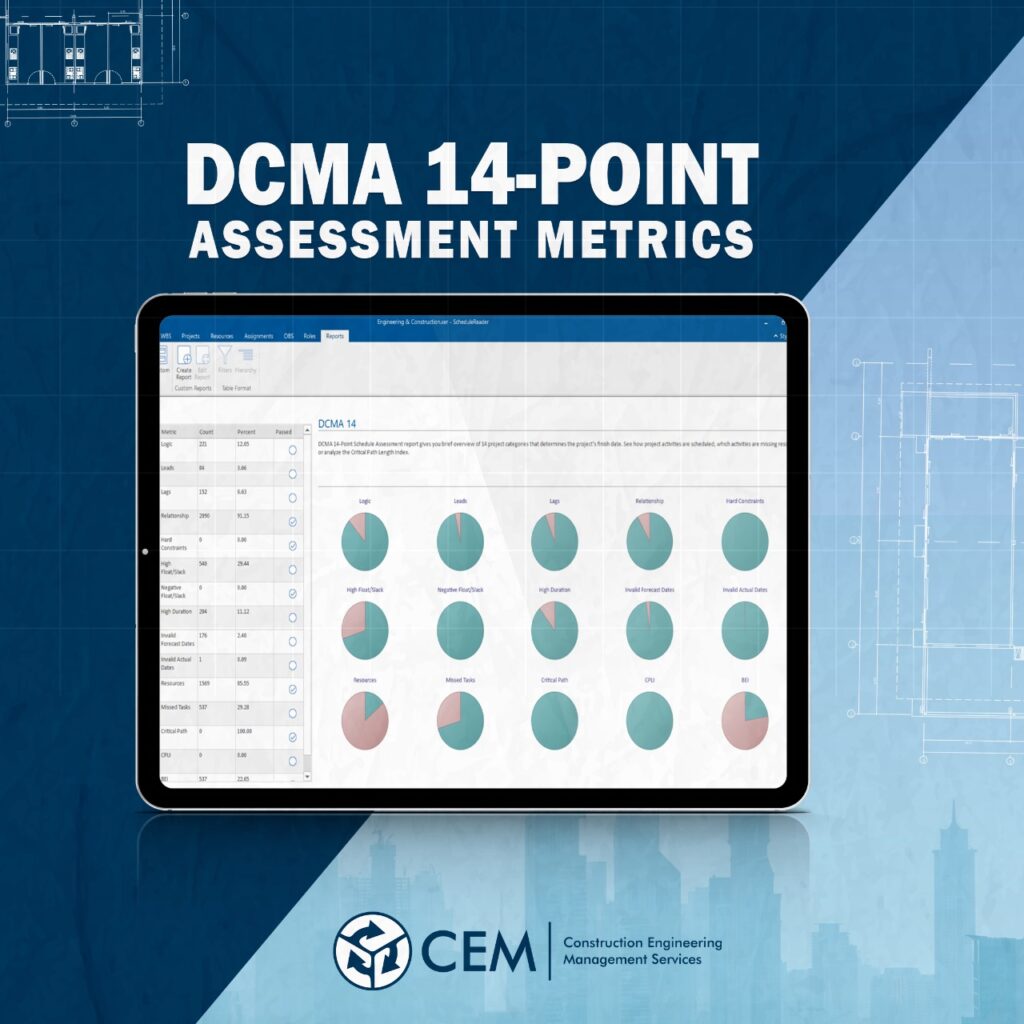The DCMA 14-Point evaluation is designed to verify that schedules are of high quality, comprehensive, and have a high likelihood of success. The DCMA (Defense Contract Management Agency) implemented it in 2005 to guarantee that projects worth more than $20 million followed best practice requirements.
The US Defense Department receives hundreds of contracts each year and has many more projects in the works, and it employs the DCMA 14-point evaluation to protect both the contractor and the Department of Defense (DoD) in their schedule duties. The DCMA’s 14-point evaluation guarantees that projects submitted adhere to these best practice principles and are therefore deemed high-quality schedules.
The DCMA 14-Point evaluation has become a trusted industry measure over time. Some of the project management software industry’s titans, such as Deltek Acumen Fuse, have included it in their software as a known industry best practice.
The DCMA’s 14-Point Evaluation is a good set of rules for scheduling. This is important for checking various forms of schedules, including those supporting Earned Value Management (EVM) and projects beyond the realm of government contracting.
The DCMA 14-Point Evaluation
- Logic: Does the schedule make sense? Is there a missing link? We all know that a schedule is a network, and if that network is incomplete due to lacking logic, an accurate critical path cannot be calculated.
- Negative lags (leads) – are not allowed in scheduling because they are confusing and disrupt the flow of the schedule. Positive lags are often used to substitute leads, but this isn’t always the best option. Shorter known activities linked by FS linkages with no delays are preferable.
- Lags: The DCMA allows positive lags, but there is a limit on how many may be used in a schedule. Lags are limited to no more than 5% of all activity relationships. Replace lags with activities that describe the effort or process, such as cure time, as the best alternative. Lags are restricted to 5% to maintain schedule clarity.
- Finish-Start Relationships: While both Primavera P6 and Deltek Acumen Fuse support all relationship types, according to the DCMA evaluation, 90 percent (or more) of schedule dependencies should be Finish-Start relationships (FS). Start-Start (SS) are okay, but utilizing SS to design a whole timetable is plainly inappropriate.
- Logical Constraints: These can have a significant impact on logic and prevent a timetable from being logic driven. According to the DCMA evaluation, hard constraints should be restricted to 5% of uncompleted activities. Any kind of constraint is generally undesirable, and a schedule should be free of them.
- High Float – Activities may be connected incorrectly, causing stress on the critical path. Because total float values are restricted to 44 days, evaluate tasks with more than 2 months of total float and limit their use to 5% of incomplete activities.
- Negative Float: Schedules with negative float activities are already behind schedule. The DCMA recommends avoiding negative float in your schedule. If there is negative float, it must be accompanied by a documented strategy to avoid being late.
- Long-Duration Tasks: Keep long-duration tasks to no more than 5% of all unfinished tasks. To facilitate schedule updates and reporting activities, task durations should be no more than two months. Break up large actions into small ones for more detail.
- Invalid Dates: Forecasted (future work) work should not be in the past, and accomplished work should not be in the future. Under no circumstances are invalid dates permitted; this prevents nonsensical scenarios in which future work is scheduled for the past and accomplished work occurs in the future.
- Resources: Although resource loading is not essential, the DCMA prefers schedules that are resource and cost loaded. If you go this route, make sure the schedule is fully resource-loaded. Except for milestones, all activities must have a cost or related resource.
- Missed Tasks: This check examines how many activities were completed late in comparison to the baseline date, checking for excessive slippage. Only 5% of activities may be late due to unforeseen circumstances. This metric is a cautious and retrospective measure of schedule progress, but it’s a useful general check to evaluate whether your project will be completed on time.
- Critical Path Test: validates that the schedule has a single continuous link from start to end. It checks the integrity of a schedule’s critical path for fluidity, which is driven by solid logic linkage.
- Critical Path Length Index (CPLI): The Critical Path Length Index (CPLI) is a forward-looking metric that analyses the efficiency necessary to execute the project on time. It calculates the proportion of the project critical path length and total float to the project critical path length. The critical path length is the number of workdays required to complete the project from the present date. The goal figure is 1.0, and schedules with a CLPI of less than 0.95 must be reviewed further.
The CPL is the length in workdays from the data date until the next schedule milestone that is being measured. TF is the number of days a project can be delayed before it delays the project completion date. TF can be negative, which means that the programme is behind schedule. The mathematical calculation of total float is generally accepted to be the difference between the “late finish” date and the “early finish” date (late finish minus early finish equals total float). The formula for CPLI is as follows:
The Critical Path Length Index (CPLI) is calculated as (CPL + TF)/CPL.
- Baseline Execution Index (BEI): The Baseline Execution Index (BEI) is an early warning sign indicating a schedule is in danger of missing a deadline. Most scheduling software does not have a BEI variable. The advanced, nontrivial, and deliberate warning provided by the BEI ratios makes the calculation worthwhile. A BEI of 1.0 indicates that the timetable is on track.
Summary
There are various benefits to using the DCMA 14-Point evaluation on your own schedule. Schedulers can avoid common mistakes that might impair the quality of their schedules. Auditing your own schedule using the tools provided by Deltek Acumen Fuse simplifies the examination.



